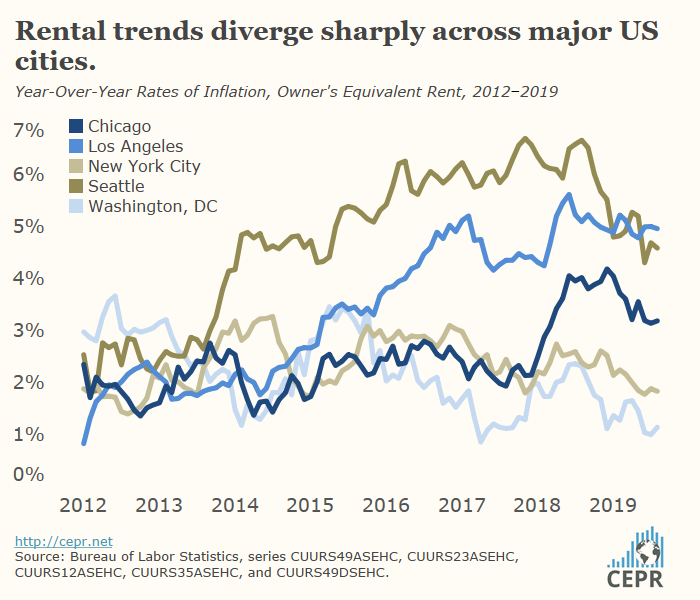Overall US CPI Flat In September, Core Index Up 0.1 Percent – Analysis
By Dean Baker
The overall Consumer Price Index (CPI) was unchanged in September, while the core index rose 0.1 percent. This brings the change in the overall CPI over the last 12 months to 1.7 percent, while the core index has risen 2.4 percent. There is little evidence of any acceleration in the overall CPI, with the annual rate of inflation for the last three months (July, August, September), compared with the prior three months (April, May, June), at 1.8 percent. However, the annualized rate for the core index does show some pick-up in inflation, coming in at 3.0 percent.
Rent continues to be, by far, the largest single factor driving inflation. The shelter index rose 0.3 percent in September and is up 3.5 percent over the last year. The core index, excluding shelter, was flat in September and was up 1.5 percent over the last year.
But rent is not a factor behind the acceleration in the core index. In fact, it seems that inflation in rental costs may be slowing modestly. The annualized rate of inflation, comparing the last three months with the prior three months, for the owners’ equivalent rent (OER) index was 3.2 percent, down from a 3.4 percent increase over the last year.
There are sharply divergent patterns across cities. In Seattle, the 12-month inflation rate for OER had peaked at more than 6.5 percent last year. It is now just over 4.5 percent. In Chicago, the inflation rate for OER had been close to 2.5 percent before rising to more than 4.0 percent last year. It has since fallen back to just over 3.0 percent. The inflation rate for OER in Los Angeles is still close to its high of 5.0 percent.
The inflation rates for OER in both New York and Washington, DC, are both low and trending slightly downward. In the case of New York, the inflation rate is just under 2.0 percent. For Washington, DC, it is just over 1.0 percent.

The main factor leading to the acceleration of inflation is medical care. The index for medical services rose 0.4 in September. It is up 4.4 percent over the last year. Inflation in this component is in turn being driven overwhelmingly by the health insurance index. The price of health insurance rose 1.4 percent in September. It has risen 18.8 percent over the last year. This index is not measuring insurance premiums, it is measuring the profits and administrative costs of insurers.
Inflation in most other components of the CPI continues to be under control. New vehicle prices fell 0.1 percent last month and are up just 0.1 percent over the last year. Used vehicle prices, which are highly erratic, fell by 1.6 percent in September and up 2.6 percent for the last year. Apparel prices fell 0.4 percent in September and are down 0.3 percent for the last year.
Tobacco prices, which account for 0.9 percent of the core index, rose 0.6 percent in September and have risen 5.9 percent over the last year. However, this is largely due to the policy choice to discourage smoking, not underlying inflation trends.
The price of food at home was unchanged in September and has risen by just 0.6 percent over the last year. The price of food away from home rose 0.3 percent in September and is up 3.2 percent in the last year. This difference is likely explained by the relatively rapid increase in pay for workers in the restaurant industry.
The energy index fell 1.4 percent last month and is down 4.8 percent over the last year. This helps dampen inflation, not only because it is a major component in the CPI, but also because energy prices feed directly into other components, most importantly rent — which often includes utilities — and air transportation.
This report indicates that inflation continues to be well under control in most sectors. Rent continues to outpace the overall CPI, but the rate of rental inflation is not accelerating and may be headed downward. The biggest factor pushing core inflation higher is double-digit rises in the cost of health insurance.

